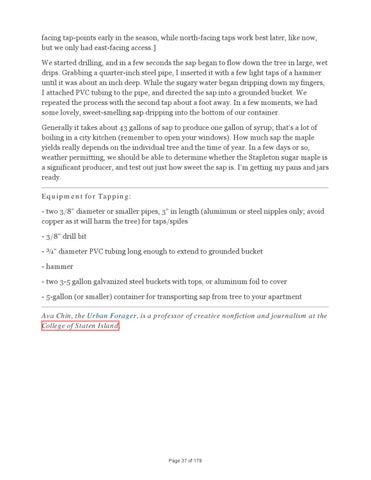facing tap-points early in the season, while north-facing taps work best later, like now, but we only had east-facing access.] We started drilling, and in a few seconds the sap began to flow down the tree in large, wet drips. Grabbing a quarter-inch steel pipe, I inserted it with a few light taps of a hammer until it was about an inch deep. While the sugary water began dripping down my fingers, I attached PVC tubing to the pipe, and directed the sap into a grounded bucket. We repeated the process with the second tap about a foot away. In a few moments, we had some lovely, sweet-smelling sap dripping into the bottom of our container. Generally it takes about 43 gallons of sap to produce one gallon of syrup; that’s a lot of boiling in a city kitchen (remember to open your windows). How much sap the maple yields really depends on the individual tree and the time of year. In a few days or so, weather permitting, we should be able to determine whether the Stapleton sugar maple is a significant producer, and test out just how sweet the sap is. I’m getting my pans and jars ready. Equipment for Tapping: - two 3/8” diameter or smaller pipes, 3” in length (aluminum or steel nipples only; avoid copper as it will harm the tree) for taps/spiles - 3/8” drill bit - ¾” diameter PVC tubing long enough to extend to grounded bucket - hammer - two 3-5 gallon galvanized steel buckets with tops, or aluminum foil to cover - 5-gallon (or smaller) container for transporting sap from tree to your apartment Ava Chin, the Urban Forager, is a professor of creative nonfiction and journalism at the College of Staten Island.
Page 37 of 179
